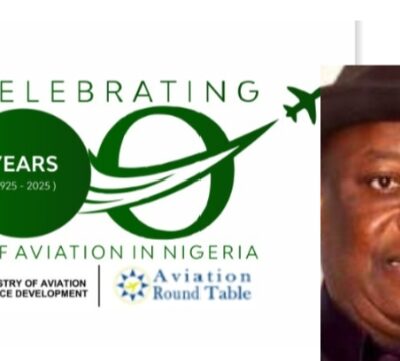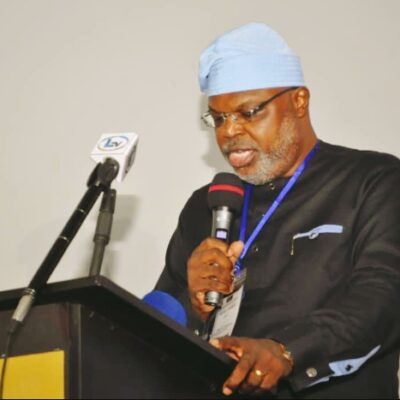
BY OLAPEJU OLUBI
The Nigerian media ecosystem has been lauded as a good catalyst powering airport business growth in the country.
This was the fulcrum of a presentation made by Dr. Chinedu Eze, a veteran aviation journalist and academic, at the 10th Airport Business Summit and Expo (ABSE) 2025 held at the Murtala Muhammed International Airport, Lagos.
Quoting the legendary Joseph Pulitzer, “Publicity, publicity, publicity is the greatest moral factor and force in our public life”, Eze reminded the audience that the media was not a passive observer of aviation developments but a dynamic force shaping public perception, policy direction and investor confidence.
He made the case that behind every successful airport business story in Nigeria is a media ecosystem that has worked to inform, clarify and inspire.
He maintained that over the years, Nigeria’s aviation media has earned the attention and respect of global stakeholders, saying International organisations such as ICAO, IATA, AFRAA and AFCAC routinely turn to Nigerian aviation reports for accurate, timely insights.
Eze noted, “Former aviation regulator Harold Demuren once confirmed this influence, while the former Group Chief Executive Officer, Ethiopian Airlines, Tewolde GebreMariam, publicly acknowledged Nigerian aviation journalists as some of the most knowledgeable in Africa. These are not just compliments — they are testaments to the strategic value Nigerian media adds to aviation development”.
Eze noted that a remarkable evolution has occurred within the media space. Sensational headlines that once screamed of near-death experiences have given way to well-researched reports, technical insights, and responsible storytelling.
His words; “The aviation press is now a pillar of the ecosystem — safeguarding the industry’s image, holding it accountable, and communicating complex developments in language the public can understand.
But that role comes with its challenges”.
One of the key hurdles, Eze said, is the reluctance of agencies and airport operators to release even basic data, adding that Whether it’s passenger movement, cargo throughput, or operational updates, journalists are too often left in the dark, forced to rely on unofficial sources.
“This not only complicates reporting but also opens the door to misrepresentation. In contrast, he pointed to countries like Ghana, South Africa, and the UAE, where such data is publicly accessible and frequently updated — strengthening trust and improving service delivery. Crises are another test of the media’s value”, he stressed.
Eze highlighted several incidents where misinformation on social media caused widespread panic — particularly a case in which passengers, after experiencing turbulence, posted videos that quickly went viral. A woman kneeling in prayer on the tarmac was painted as surviving a miracle, and another claimed prophetic warnings.
These stories, according to him left unchecked, would have stoked fear across the flying public. Saying aviation reporters, grounded in technical knowledge and guided by ethics, stepped in to explain the nature of turbulence and correct misconceptions, and their work restored calm — and confidence.
This, Eze said, is why aviation journalists often exercise self-restraint. Their silence in some cases is not complicity but responsibility. Reporting every aborted landing or technical glitch without context can be misleading.
Editors in mainstream media sometimes misread this discretion as compromise, but those who understand the sector appreciate that public panic is far more dangerous than a delayed scoop.
According to him, Despite their commitment, reporters are often met with unresponsive or ill-prepared spokespersons who lack the industry understanding necessary to provide meaningful insights.
He noted; “Agencies frequently fail to respond swiftly in the wake of incidents, leaving the media — and by extension, the public — in the dark. In today’s digital age, where narratives are shaped in seconds, this communication vacuum is risky and unsustainable”.
Eze proposed a simple but effective remedy: agencies and operators must appoint technically informed spokespersons who can speak with authority and clarity. Media engagement should not be an afterthought — it should be a core strategy. Timely, accurate information not only enhances public trust but protects the integrity of the airport business itself.
He also urged aviation authorities to embrace social media not merely as a branding tool, but as a critical communication channel.
Eze stressed, “Real-time updates, travel advisories, and operational alerts must be readily available to travellers and the general public. In an age defined by speed, airports that fail to communicate swiftly risk becoming irrelevant”.
In closing, Eze reminded the summit audience that the media’s role extends far beyond headlines.
His words; “Aviation reporters are chroniclers of growth, interpreters of complexity, and partners in national development. Their stories help shape investor decisions, guide regulatory reforms, and inspire confidence in an industry that is central to Nigeria’s economic future”.
Olapeju is a journalist and aviation reporter.





